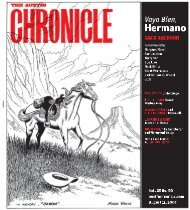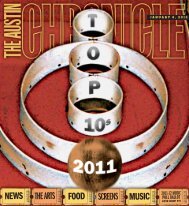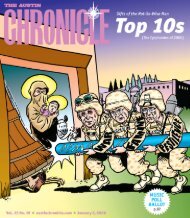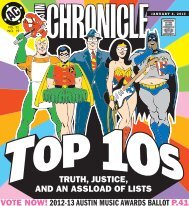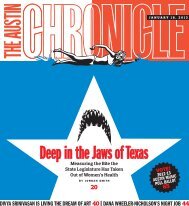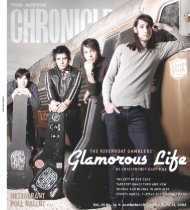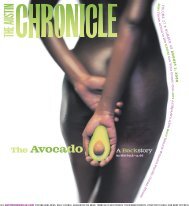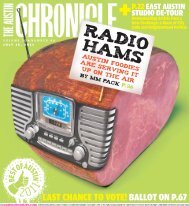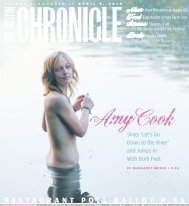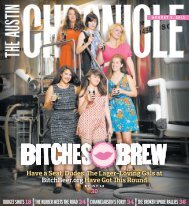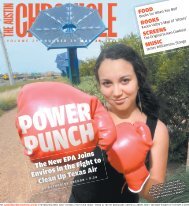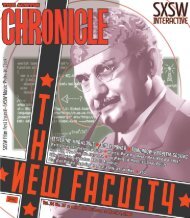Create successful ePaper yourself
Turn your PDF publications into a flip-book with our unique Google optimized e-Paper software.
NEWSLEARNING FROM DENVERMore insights from the Congress for the New UrbanismBY KATHERINE GREGORDenver was the host city for CNU 17, thisyear’s Congress for the New Urbanism nationalconference (see “Compact, Climate-Friendly,Competitive,” June 26). And it’s a good city totake lessons from, as it’s further ahead ontackling the same urban-planning issues westruggle with in <strong>Austin</strong>. Touring the city andthe region, the assembled New Urbanistsheard how Denver voters have enthusiasticallyfunded and built the projects that <strong>Austin</strong> endlesslydiscusses. We saw a big, vibrant,walkable downtown; intact olderneighborhoods with great architecturalcharacter; a central-city lightrail system with six lines; and awhole region intelligently shiftingto more sustainable lifestyles.What has Denver gotten right?Adept planning, linked to newcode, linked to new transit.BLUEPRINT DENVER: NIMBY LOVEAfter completing its Comprehensive Plan2000, Denver citizens felt the need toaddress pressing growth issues in moredetail. So the city set to work on BlueprintDenver, the city’s first integrated land-use andtransportation plan, adopted in 2002. It aimsto enhance the city’s quality of life by “usingland in a way that is healthy for its economy,supports alternative modes of transportation,and maintains the integrity of neighborhoods.”Denver’s Comprehensive Plan 2000 hadpredicted a 20-year gain of 132,000 residentsin the city proper, with the metro area receivinganother 760,000. <strong>The</strong> plan process highlightedthe need “to be more rigorous in locatingpeople where they have more choices than theautomobile to get around,” noted an article coauthoredby Jennifer Moulton and Bill Hornby.<strong>The</strong> result of “a great number of impassionedneighborhood discussions,” Blueprint Denverrecommended a fully integrated approach totransportation and land-use improvements. “Itoffers the heretical thought that some of thenew population growth be directed toward specificallyidentified areas of change, where economicand mobility needs could be satisfiedand welcomed,” said Moulton and Hornby.“It also suggests we restrain unbridledgrowth from areas of stability, primarilyresidential neighborhoods.”Here’s the takeaway organizing principle:Blueprint Denver identified and classifiedeach part of the city as either an “area ofstability” or an “area of change.” This reassuredthe neighborhood NIMBYs: Those livingin an area of stability saw that BlueprintDenver sought to protect the character anddesired traits of their established centralneighborhoods. (Even those hoods, however,are expected to accommodate some newdevelopment and redevelopment.) At thesame time, citizens downtown and in distressedor undeveloped areas saw the cityactively planning how to fix their problems –while striving not to displace them. Areas ofDEVELOPINGstorieschange were recommended for the NewUrbanist treatment: well-planned, walkableand bikeable, mixed-use, street-networked,transit-oriented dense new development.Interestingly, Blueprint Denver was led byconsultant Calthorpe Associates. CNUleading light Peter Calthorpe has consultedlocally on Envision Central Texas and CapitalMetro’s “All Systems Go!” long-rangetransit 2030 plan, among other projects. ButCapital Metro’s plan was commissionedby the transit agency, whichunlike a city has no land-useauthority; it had no actual powerto shift development patterns.To make up for lost time, the<strong>Austin</strong> City Council and managementnow need to ensure thatcomprehensive planning consultantWRT delivers (within the city’snew comprehensive plan) a detailed,fully integrated land-use and transportationplan, like Blueprint Denver. That plan willneed a corresponding land-use code, to giveit teeth and the force of law. (It also is boundto need a real rail transit system, funded andbuilt ASAP.) Problem: WRT’s scope of servicesincludes a diagnosis of the current landdevelopmentcode’s ills but not an actualrewrite or creation of a new code.‘THE NEW CODE’ – BETTER THANBAND-AIDSOnce Blueprint Denver was in place, thecity embarked on a wholesale revision of itsland-use code, to match the law to the vision.Like the plan, the code wisely pairs twin goalsof protection and growth. To engage the public,the city created the appealing, informativewebsite www.newcodedenver.org, which admitsthe old was a mess: “<strong>The</strong> current DenverZoning Code is a messy patchwork of 52years of revisions and Band-Aids.” (<strong>Austin</strong>’scode is held together with sticking plaster,too.) It champions the benefits of a rewrite:“[T]he New Code will ensure that our city’sgrowth fits our collective visions, desires andneeds” as it “incorporates ways to make ourcity more sustainable and affordable, ensuringthe value of its land as predicted growthoccurs.” Finally, “<strong>The</strong> New Code will be easierto read, and the logic behind its regulationsand procedures more transparent.”At a recent meeting of CNU’s Central TexasChapter, <strong>Austin</strong>ites were already calling for asimilar reform of our zoning code, as part ofthe comprehensive plan. New Urbanists favorabandoning a use-based code (what we havenow) for a form-based code – better understoodby most folks as a context-based code.(<strong>The</strong> Downtown <strong>Austin</strong> Alliance is currentlyorganizing a sympsium to help <strong>Austin</strong>itesunderstand form-based code and why somany cities are switching to it.) Denver’smantra: “It’s all about context.” In a nutshell,the new code says that buildings (and theirforms, e.g., shape and height) must beNew Urbanism Comes to East RiversideAt a public meeting last Thursday, June 25, a rigorousNew Urbanist vision was unveiled for the East RiversideCorridor. Comparable to some of the best plans and projectsseen at CNU 17 in Denver, the draft master plan hingeson the premise that rail transit will run down RiversideDrive, between I-35 and Ben White, and on out to the airport.Leveraging the transformational powers of transit-orienteddevelopment, the corridor plan shows East Riversidelosing its car focus (e.g., a blur of parking lots and stripshopping centers) in favor of a people focus (attractiveplaces to walk, recreate, eat, shop, and live). Handsome three-storyarchitecture surrounds transit stops; East Riverside itself features bike lanes, frequentbus service, street trees, shade features, improved pedestrian crossings, landscaped sidewalks,new parks, and creek-front green space and trails.Consultant A. Nelessen Associates Inc. used a visual preferences study – in which <strong>Austin</strong>itespicked photos of good-looking places they liked – to document a strong citizen desire for a NewUrbanist redo. Now, how to ensure that the promising plan doesn’t remain a pie-in-the-sky vision? <strong>The</strong>consultant recommends rezoning the area; city planning staff hope to complete that in about a year. (Asan immediate fix, City Council will vote soon on rezoning the eastern stretch of East Riverside, makingthe entire frontage a core transit corridor – which kicks in commercial design standards.) As in Denver’snew zoning, the new zoning code would designate six land-use districts, each with context-based andform-based rules. Neighborhood streets wouldn’t be allowed any more height, but transit-oriented developmentwould allow commercial districts to rise five to six stories, with optional density bonuses.Council also will need to provide a funding mechanism, such as tax-increment financing, for thecrucial streetscape improvements, pocket parks, and other public investments. And, oh, don’t forgetthat city of <strong>Austin</strong> rail line! Mayor Lee Leffingwell campaigned on the promise of a transportation bondelection next year; he hopes it will fund <strong>Austin</strong>’s long-discussed rail-transit system. If the Riversidesegment wins voter approval (even as a future phase), transit-oriented development promises to leavethe station years before the actual train.– K.G.To review the draft master plan (which goes to council in September) and to comment online,visit www.eastriversidecorridor.com.This is how East Riverside Drivelooks today.designed to fit gracefully into the surroundingneighborhood or district.Denver’s new zoning will require buildings tofit within one of six different “contexts”derived from “the existing and desirable characteristicsof Den ver’s diverse neighborhoods.”<strong>The</strong> choices: suburban, urban edge, urban,general urban, urban center, and downtown.(<strong>The</strong>y also threw in “special contexts.”) WhileBlueprint Denver provided the vision and initialstrategy, a community-based Zoning Code TaskForce has been working on the effort since2005. After years in the oven, a draft of thenew code finally is out for public review beforegoing to City Council for adoption (see therezoning map at www.newcodedenver.org).RAIL TRANSIT: MAKING FASTRACKSBlueprint Denver also led to a successfulNovember 2004 rail referendum, supportedby the business community, in which votersstrongly approved FasTracks – a $4.7 billionSeaholmMLKProposedurban railRIVERSIDEABIAThis is how it could look under theEast Riverside Corridor Plan.transit system to be built out over 12 years,funded with a 0.4-cent sales-tax increase.<strong>The</strong> system will add 122 miles of new urbanand regional rail service and new bus routesin the metro area.Since that vote, projected project costshave swelled to $7.9 billion, while the transitagency’s sales-tax revenues sunk with therecession (like Capital Metro’s), leading to a$2 billion shortfall. Yet rather than cut elementsor extend construction timelines, aJanuary survey showed that most Denver voterspreferred to double the tax increase toget the system done on schedule – becausethey believed in it so much. What was mostfascinating to see in Denver – and in historictowns such as Golden and Arvada on theplanned new lines – were the handsome newpublic spaces and transit-oriented projectsthat are already open and bustling, eventhough the new rail stations won’t open foryears. If you build it (or just vote to fund it),New Urbanists will come.COURTESY OF CITY OF AUSTINand El18 T H E A U S T I N C H R O N I C L E JULY 3, <strong>2009</strong> a u s t i n c h r o n i c l e . c o m



